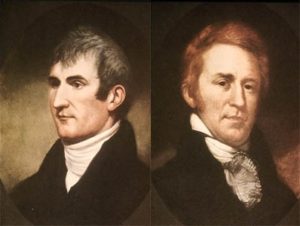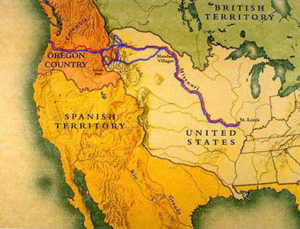The most famous explorers of the American west are Meriwether Lewis and William Clark, who traveled from St. Louis to the Pacific Ocean and back during 1804-1806. The story of their adventure is a foundation of American folklore.
Meriwether Lewis was an experienced soldier and frontiersman who also served as personal secretary to President Thomas Jefferson. Jefferson asked Lewis to undertake a journey across the west, to chronicle the natural history, draw maps and make peace with the Native Americans who lived in the region. Lewis asked his former military leader, William Clark, to join him on the expedition as co-leader. Clark was also a veteran frontiersman and a skilled draughtsman. Together they gathered a crew of about 40 men and the necessary supplies to make the trip.

The group—known as the Corps of Discovery—set off on May 14, 1804, from Camp Wood, near St. Louis, Missouri. They poled, paddled and pulled their boats up the Missouri River into present-day North Dakota, where they built Fort Mandan and stayed for the winter. The next spring, they set off again up the Missouri, reaching the headwaters. Their hope to find a water route that joined the Pacific with the Mississippi River failed, and they were guided across the mountains by Shoshone Indians. Eventually reaching the Columbia River, they floated downstream to the Pacific Ocean, where they stayed during the winter of 1805. The following spring, they made the return trip, completing their journey at St. Louis in September 1806. The total journey covered approximately 8,000 miles.

Lewis and Clark contributed greatly to our understanding of the West. They sent back descriptions and specimens of 178 plants and 122 animals previously undescribed by science, including the grizzly bear, prairie dog, pronghorn antelope, sagebrush, Douglas fir and ponderosa pine. They drew remarkably detailed and accurate maps of the entire region, used as the standard maps until the 1840s. They dealt peacefully with many Native American nations, and their success was in many ways tied to the help of those native peoples; the most famous of which was Sacagawea, who accompanied the expedition for much of the time.
References:
Buckley, Jay H. 2018. Lewis and Clark Expedition. Encyclopedia Britannica. Available at: https://www.britannica.com/event/Lewis-and-Clark-Expedition. Accessed May 10, 2018.
Clark, Linda Darus. Lewis & Clark Expedition (adaptation). National Archives. Available at: https://www.archives.gov/education/lessons/lewis-clark. Accessed May 10, 2018.
History. Com. Lewis and Clark. Available at: https://www.history.com/topics/lewis-and-clark. Accessed May 10, 2018.
